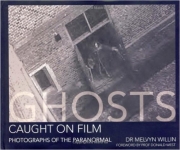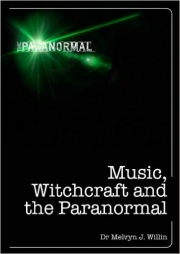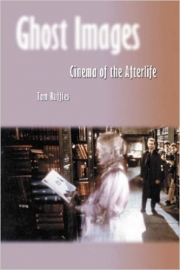From the publisher’s website: In a retirement community in the desert of southern Arizona, Jack and Chloe Monroe have an unwanted guest. What once appeared merely strange has now taken on sinister overtones. What once seemed a curiosity now seems terrifying. Paranormal researcher Dr Luke Jackson reluctantly takes up the investigation and finds himself drawn into the series of unexplained events at the Monroe house. Time is against Luke. He has just one week to unravel the mystery before he must return home. The Hidden Whisper offers a rare opportunity to enter the intriguing world of the paranormal through the eyes of Luke Jackson. It is supported by a set of endnotes compiled by the author, parapsychologist JJ Lumsden, which offer additional explanations into many of the topic areas raised throughout the story.
New Books and Media
The Hidden Whisper, by J.J. Lumsden
Publish Date: June, 2008

William Crookes (1832-1919) and the Commercialization of Science, by William H. Brock
Publish Date: June, 2008

From the publisher’s website: William Crookes' long life was one of unbroken scientific and business activity, culminating in his appointment as President of the Royal Society in 1913. Throughout his career he was an important science journalist, the discoverer of thallium, the inventor of the radiometer, investigator of cathode rays and the vacuum, a spectroscopist of significance in rare earth chemistry, and a spokesman for a chemical solution to the problems with the world's food supplies. He was also, and perhaps most controversially, an occultist who played a significant role in spiritualism in the 1870s, and was involved with D.D. Home (Browning's Mr Sludge) and other notable mediums of the day. Previous literature on Crookes has tended to focus on his involvement with the spiritualists, sometimes to the detriment of his many scientific achievements. This biography of William Crookes gives us the whole man: one of the most complex, public, and interesting figures in the history of science.
Professor Brock guides us through the abundant catalogue of Crookes' accomplishments, placing his scientific activities in the context of the business of making a living from science - something that Crookes did principally as a science journalist and editor with his Chemical News (the model for today's Nature), and by business enterprises ranging from water analysis, sewerage schemes, and goldmining to the design of electric light bulbs. We also see Crookes in the lab, as an independent researcher, and learn the processes behind his discovery of thallium, his investigations into matter and energy, and his crucial work on cathode rays. We see the public man, the celebrity who was much sought after for his opinions on the latest discovery, and who was widely regarded as Britain's leading scientist at the beginning of the twentieth century.
Scientist, spiritualist, entrepreneur: Sir William Crookes' extraordinary life and many endeavours provide a unique window into Victorian and Edwardian science and industry.
Life After Death: Some of the Best Evidence, by Jan Vandersande
Publish Date: May, 2008

From the publisher’s website: It's the essential-and seemingly unknowable-question that has haunted mankind since the beginning: What happens after we die? In Life After Death: Some of the Best Evidence, renowned physicist Dr. Jan W. Vandersande surveys evidence for an afterlife and finds a lot of the observed physical phenomena both credible and compelling.
Intended for skeptics and believers alike, Life After Death condenses more than 100 years of literature and testimony-including the author's own psychic experiences as a longtime member of a psychic circle-to sort out the astonishing from the fraudulent. The investigation gives readers a front-row seat to séance rooms to experience such marvels as direct voice, ectoplasm and materializations-messages and events, he shows, that are directed from beyond the grave. As the book makes clear, the occurrences during such episodes, though fantastical, can't be dismissed as mere fantasy or fraud.
Through historical accounts, photographs and personal experience, this engagingly written work adds to a growing body of evidence for the existence of an afterlife that's increasingly difficult to ignore.
The Parapsychology Revolution: A Concise Anthology of Paranormal and Psychical Research, edited by Robert M. Schoch and Logan Yonavjak
Publish Date: January, 2008

From the publisher’s website: Grounded in both scientific acumen and constructive inquiry, this anthology shines a rare, clarifying light on the controversial realms of psychical and paranormal research, surveying reports, essays, and arguments from more than a century of investigation into matters such as clairvoyance, telepathy, and past-life regression.
In the past one hundred and twenty-five years-despite a relative paucity of funding and the troubling persistence of fraud-serious inquiry into the paranormal, particularly as it relates to clairvoyance and psychical perception, has successfully entered the scientific age.
Studies in the modern laboratory, employing rigorous methodology and peer-reviewed oversight, have conclusively detected statistical anomalies that suggest the presence of some not yet understood faculty of the human mind. In The Parapsychology Revolution, Robert M. Schoch, Ph.D.-a scholar widely known for his geological theories that question the conventional dating of the Great Sphinx-and researcher Logan Yonavjak introduce and anthologize core writings that underscore the range and continuing challenges of psychical research.
Ghosts Caught on Film, by Melvyn Willin
Publish Date: August, 2007

Collection of strange and unexplained photographs which might represent ghosts and paranormal activity captured on film, complete with commentaries. 'Great gift for the spookily inclined.' --Bookseller. "Whatever your beliefs, the images examined provide an interesting talking point." -- Ghost Voices Magazine
The Paranormal and the Politics of Truth: A Sociological Account, by Jeremy Northcote
Publish Date: March, 2007

From the publisher’s website: This book is based on the author's ten-year research into the politics of belief surrounding paranormal ideas. Through a detailed examination of the participants, issues, strategies and underlying factors that constitute the contemporary paranormal debate, the book explores the struggle surrounding the status of paranormal phenomena. It examines, on the one hand, how the principal arbiters of religious and scientific truths -- the Church and the academic establishment -- reject paranormal ideas as "occult" and "pseudo-scientific", and how, on the other hand, paranormal enthusiasts attempt to resist such labels and instead establish paranormal ideas as legitimate knowledge.
The author contends that the paranormal debate is the outcome of wider discursive processes that are concerned with the construction and negotiation of truth in Western society generally. More specifically, the debate is seen as an aspect of the "boundary work" that defines the contours of religious and scientific orthodoxy.
The book paves new ground in understanding the nature of belief relating to a topic that has long held fascination to academics and lay people alike – paranormal ideas. It develops a discursive framework for understanding a contemporary social phenomenon, hence placing the study at the cutting edge of ethnographic development that seeks to integrate discursive perspectives with empirical accounts of sociological phenomena. Most importantly, the study is intended to contribute to the debate surrounding communicative action, by outlining a discursive perspective on the negotiation of ideational differences that goes beyond the incommensurability theories that have dominated the sociology of communication and knowledge.
Irreducible Mind: Toward a Psychology for the 21st Century, by Edward F. Kelly, Emily Williams Kelly, Adam Crabtree, Alan Gauld, Michael Grosso, Bruce Greyson
Publish Date: December, 2006

Publisher's Summary: Current mainstream opinion in psychology, neuroscience, and philosophy of mind holds that all aspects of human mind and consciousness are generated by physical processes occurring in brains. Views of this sort have dominated recent scholarly publication. The present volume, however, demonstrates--empirically--that this reductive materialism is not only incomplete but false. The authors systematically marshal evidence for a variety of psychological phenomena that are extremely difficult, and in some cases clearly impossible, to account for in conventional physicalist terms. Topics addressed include phenomena of extreme psychophysical influence, memory, psychological automatisms and secondary personality, near-death experiences and allied phenomena, genius-level creativity, and 'mystical' states of consciousness both spontaneous and drug-induced. The authors further show that these rogue phenomena are more readily accommodated by an alternative 'transmission' or 'filter' theory of mind/brain relations advanced over a century ago by a largely forgotten genius, F. W. H. Myers, and developed further by his friend and colleague William James. This theory, moreover, ratifies the commonsense conception of human beings as causally effective conscious agents, and is fully compatible with leading-edge physics and neuroscience. The book should command the attention of all open-minded persons concerned with the still-unsolved mysteries of the mind.
Dunninger: Airwave Mentalism (CD), by Todd Karr (editor)
Publish Date: May, 2006

From the publisher’s website:
The Ultimate Collection of the Master Mentalist's Radio Broadcasts --16 tracks in all!
Joseph Dunninger (1892-1975) popularized the art of mentalism with his 1940s radio show Dunninger the Master Mentalist. You’ll see why audiences loved listening to his shows as he reads the minds of his audience and answers their questions. A household name, Dunninger also frequently appeared as a guest star on other programs, and this CD includes four of his guest spots, including one with the great Jack Benny.
12 Dunninger the Master Mentalist radio shows. Additional radio shows guest-starring Dunninger. Dunninger’s readings for audiences members, more than seven hours of Dunninger broadcasts.
Mentalists and magicians alike will love this rich source of insights into mindreading for the public, showmanship, cold reading, and mentalism presentation! The CD includes the best available copies of these impossible-to-locate albums, digitally restored for optimum audio quality.
Convenient mp3 format on CD
Music, Witchcraft and the Paranormal, by Melvyn Willin
Publish Date: August, 2005

Synopsis: "Music, Witchcraft And The Paranormal" is a series of essays on parapsychology and psychical research with special reference to the importance of music in paganism and witchcraft. The book is excellently researched using a myriad of sources including historical and first-hand accounts, relevant publications and of course the author's own thorough investigations. Melvyn Willin, an expert on music and the paranormal or 'paramusicology', analyses the links between these fields through controlled experiments where music is used to make telepathic contact between two individuals. Spiritualists, psychics and mediums who claim their contact with dead composers allows them to write and perform music of startling similarity to the original composers' works are also scrutinised. Willin investigates too the claims of those who have heard 'ghostly' music, that is music being heard when there is no obvious sound source. Willin then discusses the place of music in pagan and witchcraft culture and ritual. Music in witchcraft before and at the start of its modern revival is examined as well as the history of witchcraft's personification in classical music.
"Music, Witchcraft and the Paranormal" concludes by bringing music in paganism up to date with details of its use in modern rituals.
Ghosts on the Underground: A Documentary that Reveals Just How Haunted the Tube Really Is, by Joe Kane (director)
Publish Date: April, 2005

From the producers: Ghosts on the Underground is a journey through the oldest Underground network in the world. One billion people a year descend 150 feet below London into the tunnels and stations of the tube without a second thought for the huge number of deaths on the network and the graves, church crypts and plague pits that the Underground has disrupted over the years. Ghosts on the Underground shows previously unheard accounts from the people who actually work on the network, who talk for the first time on camera about their unexplainable experiences. Along the way, the program explores the more unusual nooks and crannies of the network, showing the amazing old and new architecture of the world's largest Underground network, and revealing that although millions think they know the network, none of them know just how haunted the tube really is.
Ghost Images: Cinema of the Afterlife, by Tom Ruffles
Publish Date: September, 2004

Synopsis: The possibility of life after death is a significant theme in cinema, in which ghosts return to the world of the living to wrap up unfinished business, console their survivors, visit lovers, and just enjoy a well-wreaked scaring. This work focuses on film depictions of survival after death, from meetings with the ghost of Elvis to AIDS-related ghosts: apparitions, hauntings, mediumship, representations of heaven, angels, near-death experiences, possession, poltergeists, and all the other ways in which the living interact with the dead on screen. The work opens with a historical perspective, which outlines the development of pre-cinematic technology for ""projecting"" phantoms, and discusses the use of these skills in early ghost cinema. English-language sound films are then examined thematically with topics ranging from the expiation of sins to ""hungry"" ghosts. Six of the most significant films, Dead of Night, A Matter of Life and Death, The Innocents, The Haunting, The Shining, and Jacob's Ladder, are given a detailed analysis. A conclusion, filmography, and bibliography follow.

